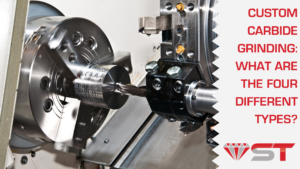No matter what type of machining you do, there’s a good chance that custom carbide grinding is going to be involved at some point. In order to get the most out of this process, it’s important to understand the different types of carbide grinding that are available. This way, you can select the right option for your specific needs.
In this article, we’ll explore the four main types of custom carbide tool grinding: surface grinding, centerless grinding, inner diameter (ID) grinding, and outer diameter (OD) grinding. Each of these techniques has its own process, equipment, applications, and advantages, so let’s take a closer look!
1. SURFACE GRINDING
As the workhorses of the machine shop, surface grinders boast powerful spindles, as well as the ability to have multiple wheel packs loaded into the machine to increase the capability to do complex tool operations.
Surface grinding is the most common type of custom carbide grinding—and it’s also one of the simplest. The process involves a rotating wheel that removes material from the top surface of a workpiece. Surface grinding can be accomplished with either horizontal or vertical wheels, and it’s also possible to use multiple wheels at once for increased efficiency.
Surface Grinding Applications
Surface grinding is used for a variety of applications, but is typically used to create flat, level surfaces. This method is also commonly used to remove burrs from machined parts, such as when you’re preparing a surface for painting, plating, or welding.
At Special Tools, we use our Bridgeport CNC Surface Grinder for a number of different jobs, such as grinding carbide tipped and HSS centerless grinder blades, as well as surface grinding customer parts or fixtures for flatness or a desired surface finish.
2. CENTERLESS GRINDING
Centerless grinding is a type of cylindrical grinding in which the workpiece is supported on its own axis, rather than being held between centers as done in traditional, “between-centers” cylindrical grinding. A typical centerless grinder has three main components: a grinding wheel, a regulating wheel, and a work rest blade.
The workpiece is fed between the grinding wheel and the regulating wheel, which rotate at different speeds. The speed of the regulating wheel controls the rate at which material is removed from the workpiece, while the speed of the grinding wheel determines how fine a finish is produced.
Centerless Grinding Applications
Centerless grinding is typically used for high-volume production runs of cylindrical parts, such as axles, shafts, and pins. This process is also used to create a smooth, polished surface on machined parts.
At Special Tools, we use our centerless grinder for grinding carbide-tipped and HSS saw blades, planer knives, and router bits, as well as custom parts or tools that need a smooth finish.
3. ID GRINDING
Inner Diameter (ID) grinding, also known as bore grinding, is the process of finishing the inside surface of a workpiece. The ID grinder is equipped with a high-precision spindle that can be fitted with various abrasive wheels, belts, and other accessories to accommodate different tool sizes and applications.
ID Grinding Applications
Because ID grinding produces such precise results, it’s often used for machining small or delicate parts—such as those used in medical devices or aerospace components. It can also be used to finish the inside surfaces of pipes and tubes.
Here at Special Tools, we use our ID grinder for finishing the inside diameters of carbide tipped and HSS saw blades, as well as router bits and other grooved cutting tools.
4. OD GRINDING
Outer diameter (OD) grinding, or external cylindrical grinding, is the process of removing material from the outside surface of an object to achieve the desired shape. An OD grinder will typically use a large grinding wheel and a chuck that rotates to grind the outside diameter of round parts. OD grinding can be used on a variety of materials, including ferrous and non-ferrous metals, plastics, and glass.
OD Grinding Applications
At Special Tools, we use our CNC-controlled Tru Tech Systems OD Grinder primarily for grinding the steel shanks on custom carbide-tipped tools that we create. These shanks are ground to an H6 tolerance (+.0000/-.0005) to ensure they fit into a tool holder properly at their final destination.
We also have a diamond grinding wheel that can be used to grind carbide for various solid carbide form tools.
ENTRUST SPECIAL TOOLS WITH YOUR CUSTOM CARBIDE GRINDING NEEDS
At Special Tools, our tooling experts have decades of experience using commercial grinding equipment and can help you get the most out of your cutting tools. We utilize surface grinding, centerless grinding, ID grinding, and OD grinding to create the tight tolerance carbide tools our customers need. Contact us today to see how we can help!
Want to learn more about custom carbide tool grinding? Check out our recent article on how to use a CNC grinder to sharpen and refine your tools.


